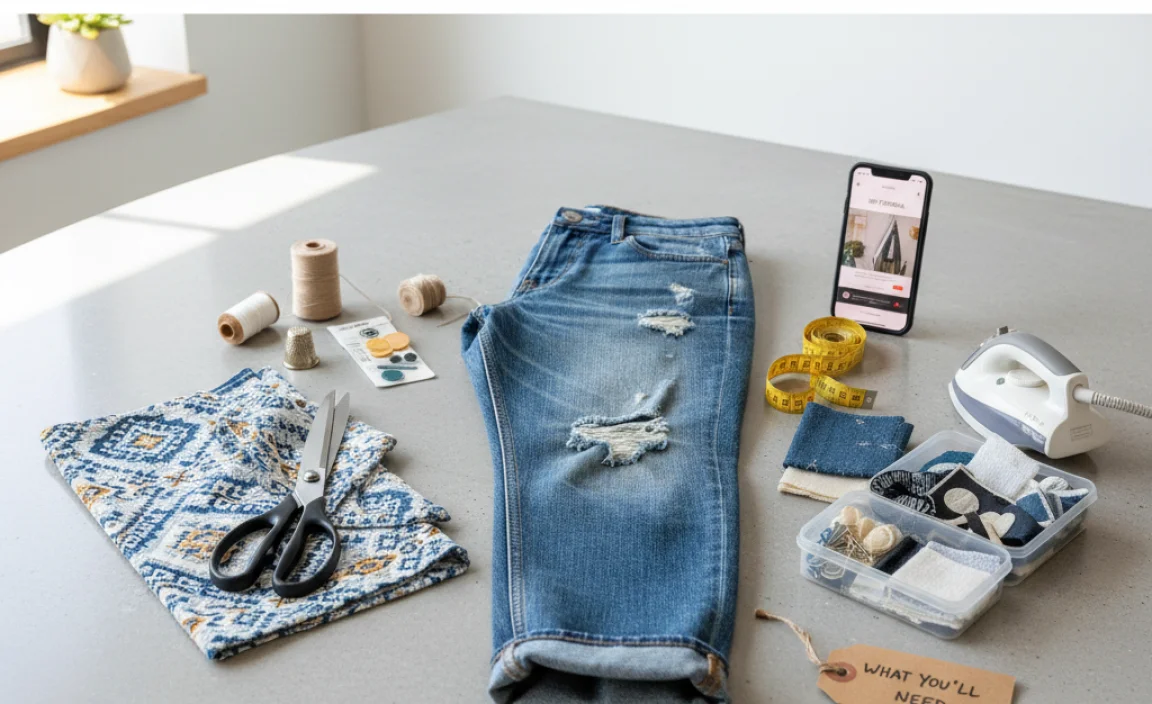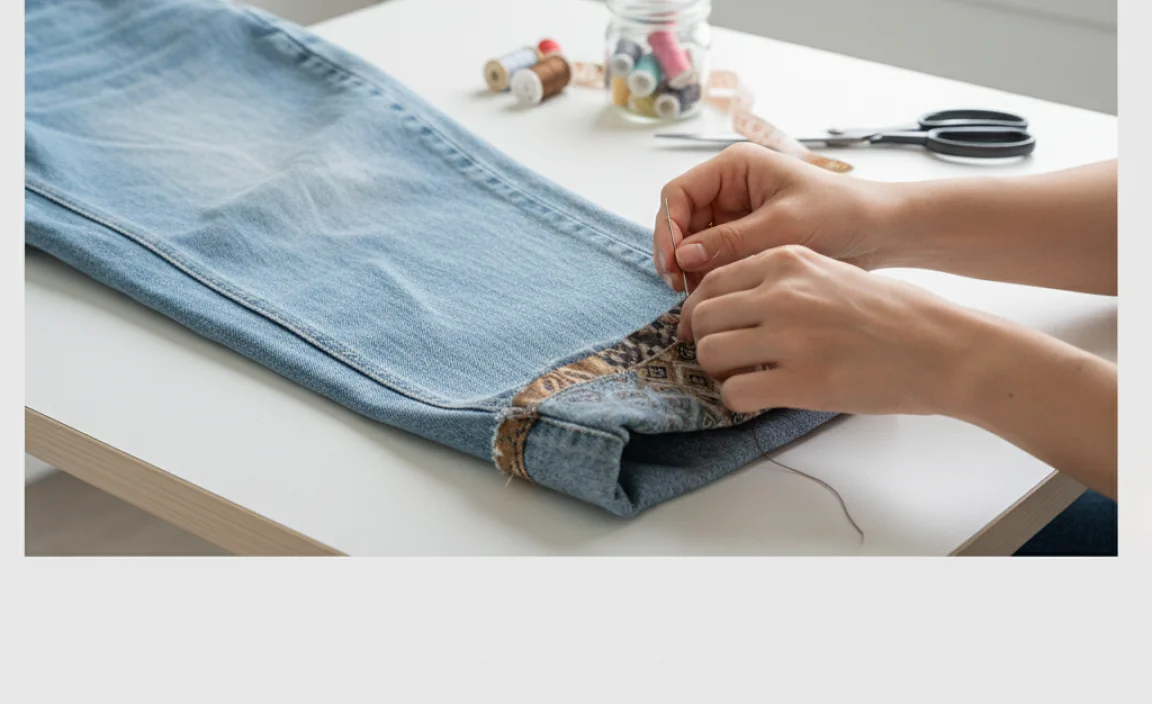Quick Summary: Easily fix baggy jeans with our genius iron-on patch hack. This no-sew method is beginner-friendly, quick, and effectively reshapes your jeans for a perfect fit.
How To Hem Baggy Jeans: Genius Patch Hack!
Do your favorite jeans have a little too much extra fabric around the ankles or waist? It’s a common frustration, especially as clothes can stretch or shrink over time, or if you’ve inherited a great pair that just isn’t quite the right fit. The good news is you don’t need to be a sewing expert to fix them. We’re going to show you a super simple, no-sew method using iron-on patches that will transform your baggy denim into a perfectly fitted pair. Get ready to give your jeans a new lease on life with this clever hack!
Why You Need This Hemming Hack

Baggy jeans can sometimes feel like a fashion sacrifice. They might be comfortable, but they can also make your silhouette feel a bit undefined. Traditional hemming often requires sewing skills, a sewing machine, or a trip to a tailor, which can be time-consuming and costly. This iron-on patch method offers a fantastic alternative for several reasons:
- Speed: You can achieve a custom fit in under an hour.
- Simplicity: No sewing machine or advanced crafting skills are needed.
- Cost-Effective: It’s much cheaper than professional alterations.
- Reversible (mostly): While designed to be permanent, some patches can be carefully removed with heat, though results vary.
- Versatility: Works on various denim types and for different fit issues (waist, length, or leg width).
Understanding the “Patch Hack”

This technique involves using iron-on hem tape or specifically designed iron-on patch adhesive fabric. Instead of sewing, you’re essentially creating a strong, fused bond to shorten or adjust your jeans. The “genius” part comes from how we strategically place and use these patches to create a clean, subtle adjustment that looks as good as a traditional hem.
What You’ll Need

Gathering your supplies is the first step to success. Here’s a checklist of everything you’ll need for this easy hemming project:
- The Baggy Jeans: Your denim that needs taming.
- Iron-On Hem Tape or Patch Adhesive Fabric: This is the magic ingredient. Look for products specifically designed for fabric fusing. Brands like Pellon or Hemstasy offer reliable options. You can find these at most fabric stores or online.
- Sharp Fabric Scissors: For precise cutting of the patches.
- Measuring Tape or Ruler: To ensure even hemming.
- Fabric Chalk or a Disappearing Ink Pen: For marking your desired hem line.
- Iron: A standard household iron will do.
- Ironing Board: A stable surface is crucial for even heat application.
- A Thin Cloth or Pressing Cloth: To protect your jeans and iron from direct heat.
- Optional: Pins: To hold fabric in place while measuring and marking.
Step-by-Step Guide: Hemming the Length of Your Jeans

Let’s get started on reducing that excess length. This is where the patch hack truly shines.
Step 1: Prepare Your Jeans
Wash and dry your jeans before you begin. This ensures there’s no leftover dirt or finishes that could interfere with the adhesion process. Make sure they are completely dry.
Try on your jeans and determine the new length you want. Use pins to mark where you’d like the hem to fall. It’s best to have someone help you with evenness, or carefully check in a full-length mirror.
Step 2: Mark Your Hem Line
Take off the jeans. Lay them flat on a clean, hard surface. Decide how much you want to shorten them. For a traditional hem look, you’ll likely want to fold up about 1-2 inches of extra fabric. This folded amount will be where you apply the iron-on patch from the inside.
Use your fabric chalk or disappearing ink pen to draw a straight line where you will fold the fabric. Measure carefully to ensure the line is parallel to the existing hem and perfectly straight all the way around.
Step 3: Fold and Press
Fold the bottom of the jeans up along the line you just marked. If you’re aiming for a clean, tucked-in hem, fold the raw edge of the fabric inwards again, so it’s hidden within the fold. This creates a “double-folded” hem appearance from the outside.
Use your iron to press this fold firmly. This will help set a temporary crease, making it easier to work with.
Step 4: Cut Your Iron-On Patch
Measure the circumference of the jean leg where you’ve made the fold. Cut a piece of iron-on hem tape or adhesive fabric that is slightly longer than this measurement. If you’re using adhesive fabric, cut a piece that is about the width of your folded hem (e.g., 1-2 inches).
Pro Tip: It’s better to have a little extra patch material than not enough. You can always trim the excess later.
Step 5: Apply the Iron-On Patch
Carefully unfold the hem you just pressed. Place the iron-on patch material between the folded layers of fabric, against the raw edge that you plan to hide. Ensure the patch is centered within the fold and runs all the way around the leg.
Place your thin cloth or pressing cloth over the area where the patch is applied. Set your iron to the temperature recommended on the iron-on patch packaging (usually a medium to high heat, without steam).
Press the iron firmly onto the cloth for the recommended time (typically 8-15 seconds per section). Work your way around the entire circumference of the jean leg, ensuring even heat application. Lift the iron; do not slide it around. This allows the heat to activate the adhesive.
Step 6: Reinforce and Finish
Once the patch has cooled slightly, run your iron over the outside of the hem again, pressing down firmly through the pressing cloth. This helps to secure the bond and create a crisp finish.
Turn the jeans inside out. If you folded the raw edge inward (Step 3), you’ll likely want to add another small piece of iron-on patch or hem tape to the inside of the folded hem for extra durability and a cleaner finish on the inside. Repeat the pressing process.
Trim any excess patch material. Allow the adhesive to cure fully according to the product instructions (usually a 24-hour period) before washing or wearing.
Step-by-Step Guide: Adjusting the Waist Gap

A common issue with some jean styles, particularly high-waisted ones, is a gap at the back waistband, leading to an unflattering look and potential discomfort. This hack can help cinch that in without complex sewing.
Step 1: Assess the Gap
Put on your jeans and stand in front of a mirror. Notice how much of a gap there is at the back waistband. You might need to pinch the excess fabric to get an idea of how much you need to reduce.
Step 2: Measure and Mark
Take off your jeans. Lay them flat. Measure the amount of excess fabric you need to remove. This might be 1 inch, 2 inches, or more, depending on the severity of the gap. You’ll want to create a dart or a tucked fold to take this excess up.
Use fabric chalk to mark where you’ll create your “dart.” A dart is essentially a small triangular tuck that removes fabric. You’ll typically create one or two central darts at the back waistband, or small darts closer to the side seams.
Step 3: Create the Dart
For a single central dart, you might want to bring the center back seam to the side seams or simply pinch the fabric from the top of the waistband down to a point about 2-3 inches below the waistband. Mark this triangle shape with your chalk.
If you’re creating two smaller darts, mark symmetrical triangles on either side of the center back seam. The length of the dart (how far down it goes) should ideally not extend past the top of the back pockets.
Step 4: Prepare Your Iron-On Patch
You’ll need to create a small piece of iron-on patch material to fuse the inside of your dart. Cut a piece of your iron-on hem tape or adhesive fabric that is slightly larger than your chalked dart shape. You might need to cut it into a more precise triangle or just a rectangle that covers the area.
Step 5: Fuse the Dart
Carefully set your iron to the appropriate heat. Place the iron-on patch material on the inside of the jeans, so it covers the marked dart area. This will be the underside of the waistband facing your skin.
Put your pressing cloth over the area and press firmly with the iron. Hold for the recommended time. You’re essentially fusing the two layers of the dart together internally.
Step 6: Refine and Secure
Once cooled, check the exterior of your jeans. The dart should look neat and have removed the unwanted gap. You may want to give the outside of the dart a final press through the pressing cloth to ensure a crisp finish.
For extra security, you can add a few small stitches with a needle and thread at the very point of the dart on the inside, though this iron-on method alone is often strong enough.
How to Hem Wider Leg Jeans (and Other Areas)
This patch hack isn’t limited to just fixing the length of your jeans. You can use it to:
- Adjust the width of wider legs: You can create a subtle inward fold on the inseam or outseam of wider legs to give them a more tapered look. This is essentially a vertical hem.
- Shorten sleeves on denim jackets: The same principle applies to denim jackets, though you’ll want to be extra careful with seam allowances on sleeves.
- Fix other clothing items: Curtains, thick cotton skirts, or even canvas bags can benefit from this no-sew hemming method.
The key is always to understand the fabric and ensure you’re pressing the adhesive evenly. For wider legs, you might need to make multiple smaller folds and fuse them individually, or create one large fused seam along the desired alteration line.
Pros and Cons of the Iron-On Patch Hack
Like any crafting or tailoring technique, this method has its advantages and disadvantages.
| Pros | Cons |
|---|---|
| Extremely beginner-friendly and requires no sewing skills. | Can sometimes create a slightly stiffer hem than sewn hems. |
| Very quick to complete, often done in less than an hour. | Durability can vary depending on the quality of the iron-on product and how well it’s applied. |
| Cost-effective compared to professional tailoring. | May require reapplication if the bond weakens over time or with excessive washing. |
| Achieves a clean, relatively neat finish that can mimic a traditional hem. | Can be tricky on very thick or bulky denim, requiring extra heat and pressure. |
| Great for quick fixes and temporary adjustments. | Removal can be difficult and may leave residue or damage the fabric if not done carefully. |
Tips for the Best Results
To ensure your hemming project is a success, keep these tips in mind:
- Read the Instructions: Always refer to the specific instructions on your iron-on product packaging. Heat settings and pressing times can vary.
- Test on a Scrap: If you’re unsure about the heat setting or adhesion, test your iron-on product on a scrap piece of fabric from an old garment or a remnant from the fabric store.
- Clean Surface: Ensure your ironing board cover and pressing cloth are clean to avoid transferring dirt or scorch marks onto your jeans.
- Even Pressure: Apply consistent, firm pressure with the iron across the entire area. Avoid random movements that can shift the fabric.
- Patience with Cooling: Allow the adhesive to cool completely before handling or testing the strength of the bond. This allows the bond to set properly.
- Consider Inside vs. Outside: For a cleaner external look, most of this process is done internally. For maximum durability, consider fusing the seam from both sides if your design allows.
- Washing Instructions: After hemming, wait at least 24 hours before washing your jeans. When you do wash, turn them inside out and use a gentle cycle with cold water. Avoid high heat drying, as this can sometimes weaken the adhesive bond over time. A good resource for fabric care can be found at the Federal Trade Commission’s Textile Fiber Products Identification Act information, which guides garment labeling and care.
When to Consider Traditional Hemming
While this iron-on patch hack is fantastic for many situations, there are times when traditional sewing might be a better option:
- Delicate Fabrics: If your jeans are made from very thin or synthetic material that might melt or scorch easily, cautious sewing might be safer.
- Thick Seams: For extremely thick denim where creating a clean, flat fold is difficult, sewing can distribute the bulk better.
- High-Fashion or Expensive Jeans: If you’re working with designer or very high-value denim, you might prefer the precision and guarantee of professional tailoring.
- Stretch Denim: While this hack can work on some stretch denim, the stretch might pull on the adhesive over time, potentially compromising the bond.
- Extremely Precise Fit: For garments that require absolute perfection and a barely-there hem, sewing offers more control.
For everyday wear and most denim situations, however, the iron-on patch method provides an excellent, accessible solution.
Frequently Asked Questions (FAQ)
Q1: Can I use regular iron-on hemming tape for this?
Yes, most iron-on hemming tapes are designed for this purpose. They create a fusible bond between fabric layers. Ensure you follow the product’s instructions for heat and time.
Q2: How durable is an iron-on patch hem?
When applied correctly with good quality iron-on adhesive and proper care (washing inside out, cool water, gentle cycle, air dry), an iron-on hem can last for many washes. However, it may not be as long-lasting as a sewn hem, especially with frequent washing and heavy wear.
Q3: Will the patch be visible from the outside?
With this “patch hack” method, the iron-on material is placed inside the fold of the denim. If you create a double-folded hem (folding the raw edge inward before pressing the main fold), the inside of the hem will be clean and the patch completely hidden. A single fold might still allow you to see the patch from the outside depending on the thickness of the denim and the patch.
Q4: Can I remove the iron-on patch if I make a mistake?
It can be tricky. Often, you can re-apply heat (sometimes higher heat, or using a hairdryer on a hot setting) to soften the adhesive and gently pull the fabric apart. Be aware that this may leave sticky residue or slight marks on the fabric. Always test on a hidden area if possible.
Q5: What if my jeans are very thick denim?
Thick denim requires more heat and sustained pressure. Ensure your iron is hot enough and press for the full duration recommended, possibly even slightly longer. You might need to do the pressing in sections. Using a spray bottle to slightly dampen the area to be fused can sometimes help conduction.
Q6: Can I use this on different types of fabric?
Iron-on adhesive works best on natural fibers like cotton and denim. It can be used on some synthetic blends, but always perform a test first, as too much heat can melt or damage synthetic fabrics. Avoid using on very delicate or sheer materials.
Conclusion
Transforming baggy jeans into a perfectly fitting pair no longer requires a sewing kit or a tailor’s appointment. This ingenious iron-on patch hack offers a quick, easy, and budget-friendly solution for anyone looking to refine their denim. By following these straightforward steps, you can confidently alter the length, adjust the waist, or even taper your jeans with minimal effort and impressive results. So, dig out those ill-fitting jeans, grab your iron, and embrace the power of a no-sew fix. You’ll be looking sharp and feeling confident in your newly customized denim in no time!











